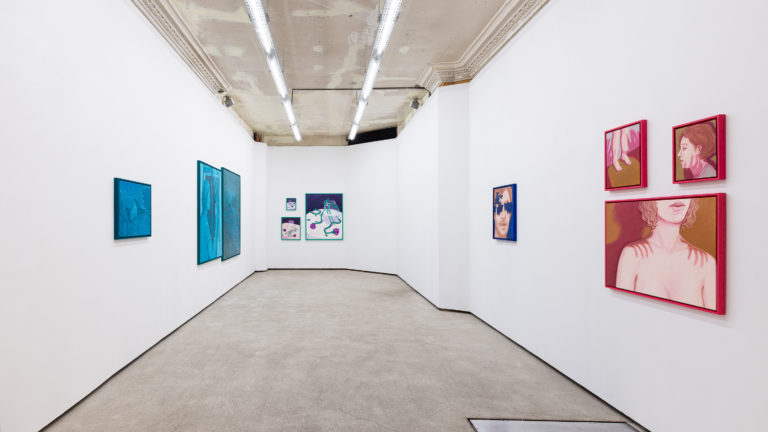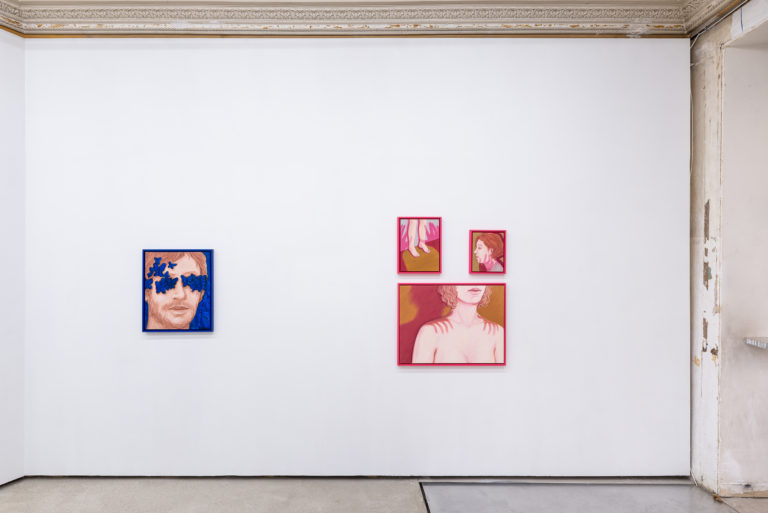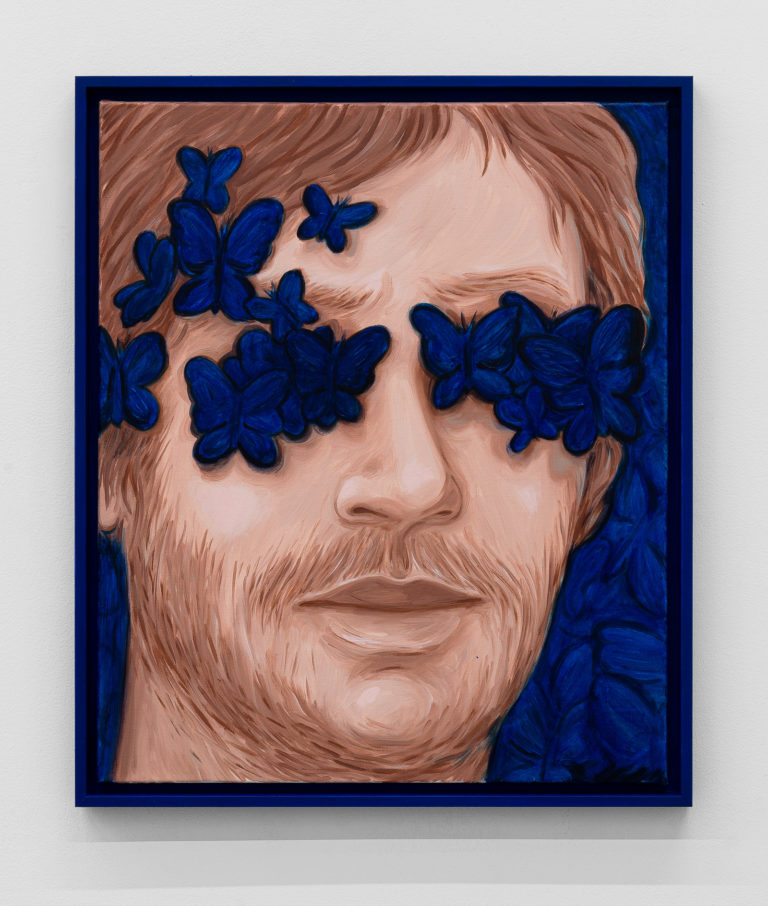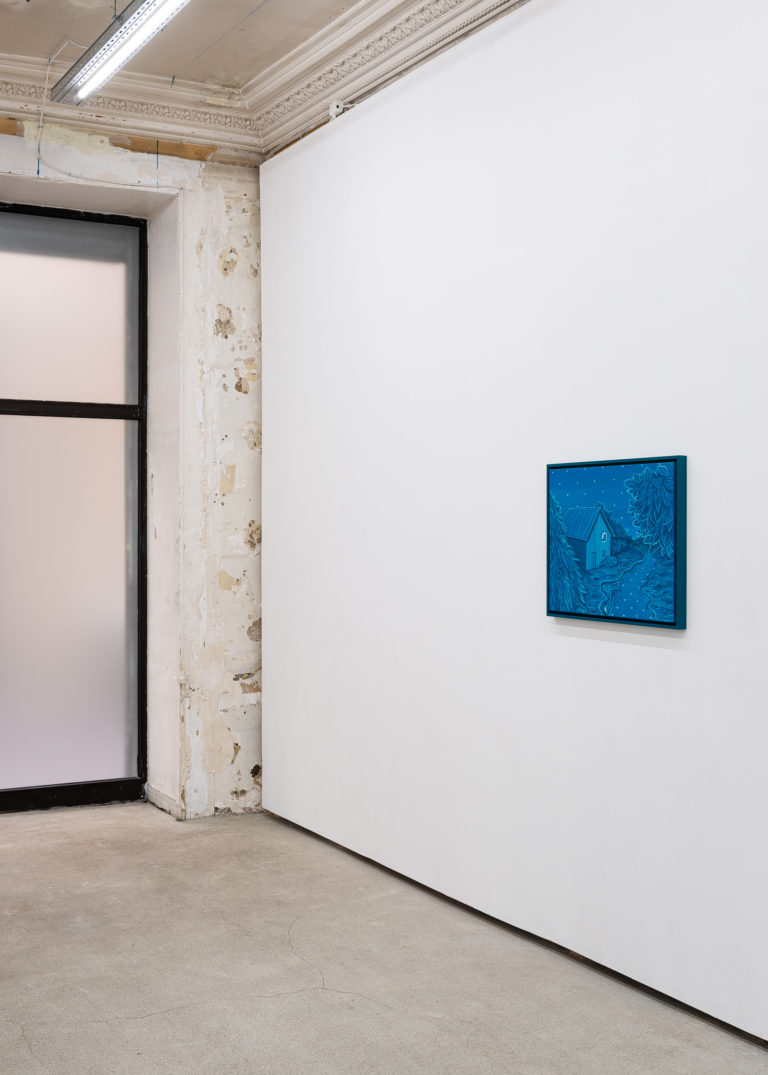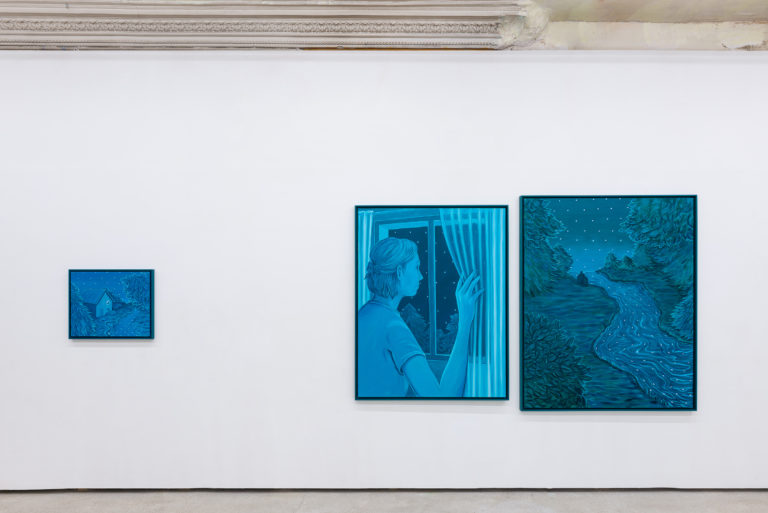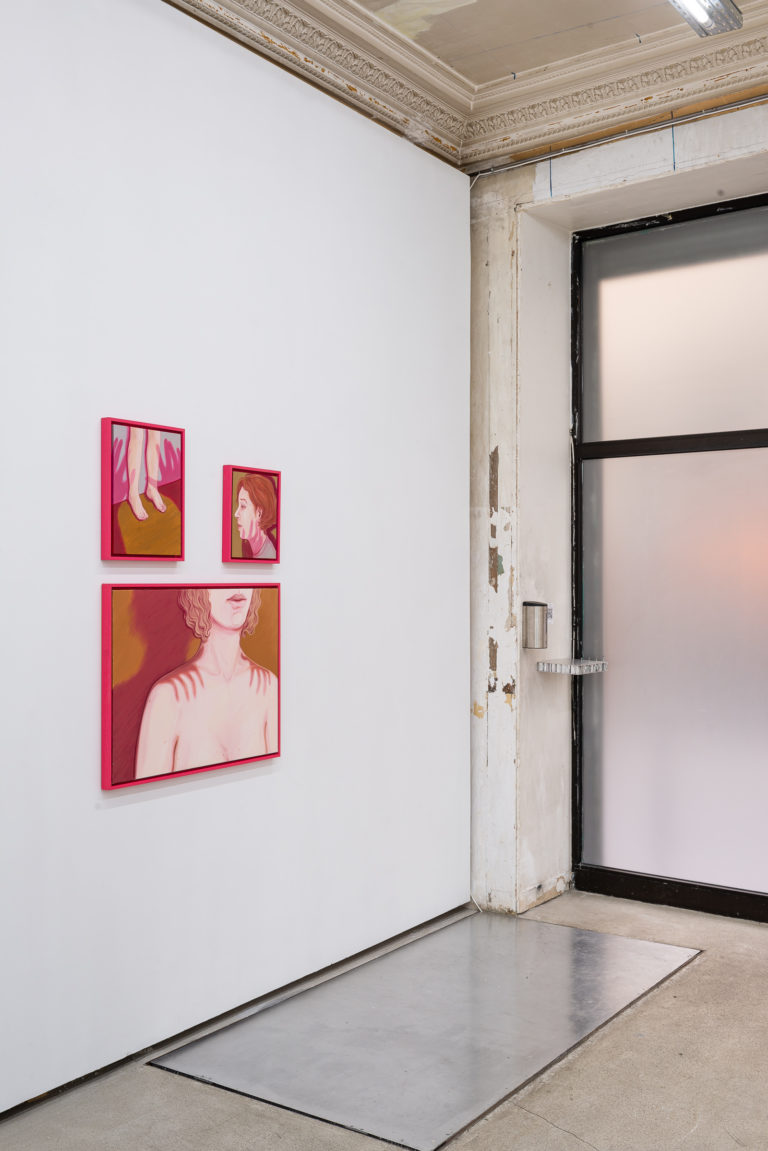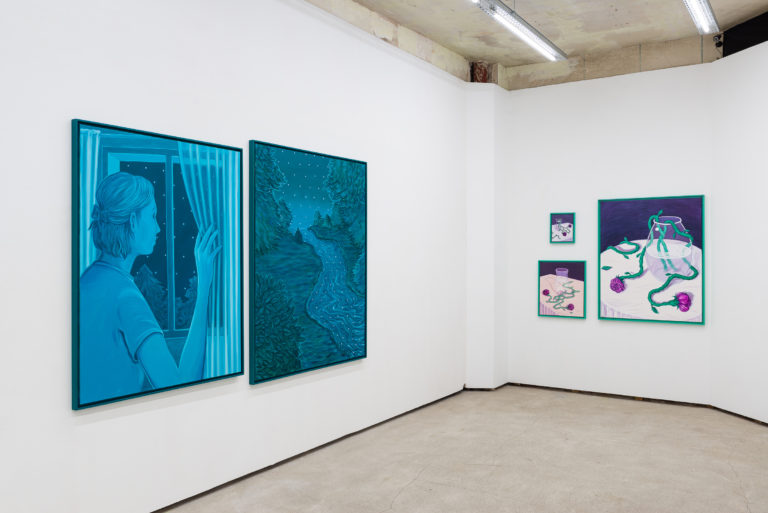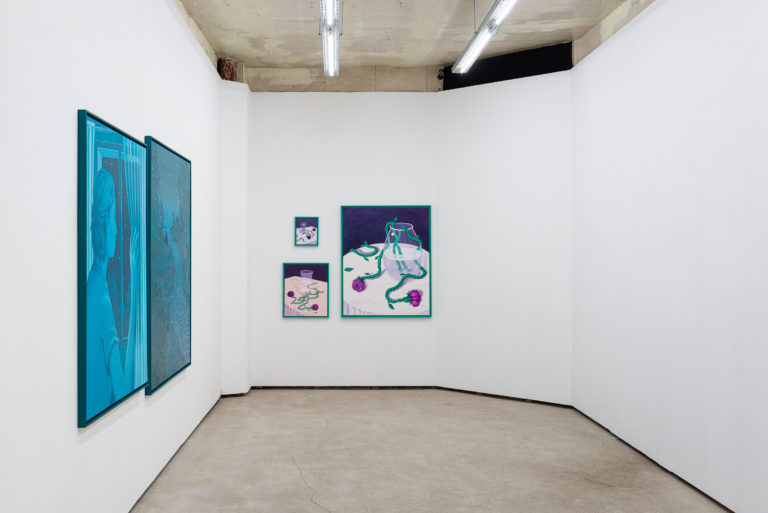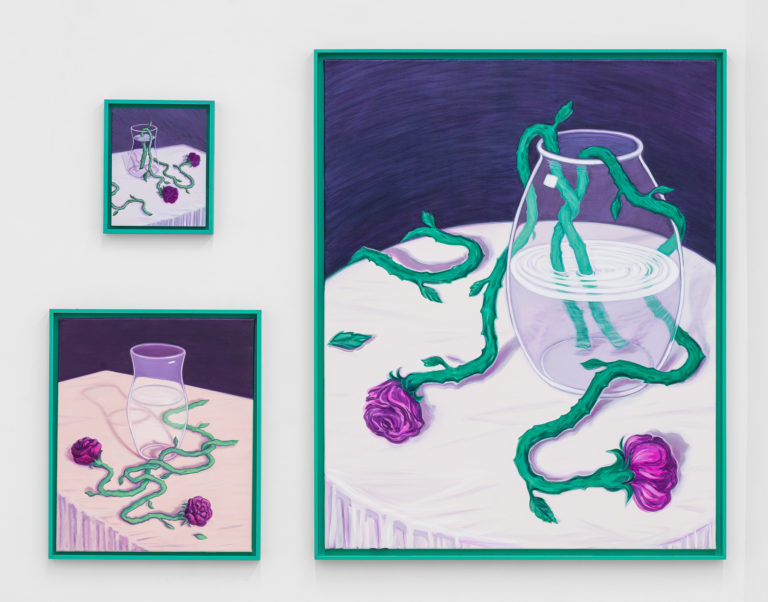Lise Stoufflet
Fabulations II
January 8 - February 12, 2022
‘[…] Our world is but one world among many. There are countless other worlds, […] [and] every way that a world could possibly be is a way that some world is.’
(David Lewis, On the Plurality of Worlds, 1986)
Like the American philosopher, a leading figure in contemporary analytical philosophy, who opened a theoretical door to a universe where countless parallel worlds coexist, all as real and as plausible as each other, Lise Stoufflet transports us into her own universe of all conceivable worlds.
Lise Stoufflet’s first solo exhibition at the Galerie Pact is titled Fabulations – the French term, in psychology, for a tendency to create imaginary narratives, which may be more or less structured and coherent, and to present them as real events. The exhibition has two consecutive parts, each one presenting several groups of new paintings in an oxymoronic confrontation of stylized compositions and dense layers of meaning. Inhabiting a space between the real and the imaginary, Lise Stoufflet’s dreamlike compositions offer an escape from the world we think we know, opening up as many interpretations as there are observers, because they speak to everyone’s individual feelings and emotions.
With their very identifiable style, clear outlines and very personal palette, the apparent simplification of the images encourages viewers to construct their own narrative. While the seemingly calm atmospheres the artist creates can at first make us forget the strangeness of the compositions, an incongruous detail or a physical impossibility will reveal a grey area: the imaginary has infiltrated reality, opening a door to the impossible.
Elements spill out of the paintings and assail the walls of the gallery, so that the imaginary breaks free from the frame and intrudes into reality: tentacles, eyes, playing cards or a starry sky anchor the artist’s fantasies in the concrete world, linking together works in the same series as though they were autonomous universes.
In the first part of the exhibition, a woman and an octopus are the protagonists in an embrace that is enigmatic, tender and sensual. Although it was the Japanese who developed the concept of shokushu gōkan, or ‘tentacle erotica’, in which creatures with tentacles have sexual relations with women – one of the earliest and most famous examples is The Dream of the Fisherman’s Wife, a print by Katsushika Hokusai (1814) – Lise Stoufflet instead explores, through this reciprocal embrace, a possible communion between humans and nature. Characterised by an apparent calm, these images reveal something mysterious: the fingers of the female figure are themselves like tentacles, and the appendages of the creature descend from the surface into the water.
Lise Stoufflet’s universe expresses not only dreams and the imaginary but also memories, current events and experiences which she approaches with metaphor, turning them into universal images, chosen for their poetic and evocative potential. After passing a group of demonstrators in the street, brandishing placards depicting eyes, the artist included them in her paintings, preserving the mystery of their meaning: some will see them as a dreamlike vision, others will be reminded of a society where scrutiny and surveillance is endemic.
The artist transforms news events into metaphorical and subliminal images. A third series of paintings is underpinned by the omnipresent media images of the many wildfires raging across the planet as a result of climate change: here a fortune-teller asks the viewer to choose one of several cards, one of which is turned up and predicts a coming catastrophe: does this indicate that our fate is already written, or that it can still be avoided?
In her ‘fabulations’, Lise Stoufflet adeptly illustrates Magritte’s statement: ‘I take care, as far as possible, to only paint paintings that arouse mystery with the precision and enchantment necessary to the life of ideas’.
« Notre monde n’est qu’un monde parmi beaucoup d’autres, il y a d’innombrables autres mondes, (…) et toute manière possible dont un monde pourrait être est une manière d’être pour un monde. » (David Lewis, De la pluralité des mondes, 1986)
Comme le philosophe américain, figure de proue de la philosophie analytique contemporaine, qui a ouvert la voie théorique à un univers où d’innombrables mondes parallèles coexistent, chacun aussi réel et plausible que l’autre, Lise Stoufflet nous transporte dans l’univers de tous les concevables qui est le sien.
Intitulée Fabulations – en psychologie, la tendance à présenter des récits imaginaires, de façon plus ou moins organisée et cohérente, comme étant réels –, la première exposition personnelle de Lise Stoufflet à la galerie Pact se déploie en deux volets consécutifs, présentant chacun plusieurs ensembles de nouveaux tableaux en une confrontation oxymorique de compositions stylisées et de significations denses et stratifiées. À la lisière entre le réel et le fantastique, les compositions oniriques de Lise Stoufflet offrent une échappatoire au monde qu’on croit connaître, une porte ouverte à autant d’interprétations qu’il y a de regardeurs, car faisant appel aux émotions et aux sentiments propres de chacun.
Dans un style très identifiable, aux contours bien définis, et dans une gamme chromatique très personnelle, l’apparente simplification des images invite le spectateur à construire sa propre narration. Si les atmosphères en apparence calmes peuvent faire oublier au premier regard l’étrangeté des compositions, un détail incongru, une impossibilité physique viennent révéler l’entre-deux : le fantastique s’est invité dans le réel, ouvrant la porte à l’impossible.
Ainsi, dans le premier volet de l’exposition une femme et une pieuvre sont les protagonistes d’une étreinte énigmatique, tendre et sensuelle. Si le Japon a vu se développer le concept de shokushu gōkan, ou « tentacules érotiques », où des créatures munies de tentacules ont des rapports sexuels avec des femmes, et dont un des premiers et plus célèbres exemples est l’estampe de Katsushika Hokusai Le Rêve de la femme du pêcheur (1814), Lise Stoufflet explore plutôt, à travers cette étreinte complice, une possible communion entre humain et nature. Empreintes d’une apparente sérénité, les images révèlent un côté mystérieux : les doigts du personnage féminin ont eux-mêmes l’air de tentacules, et les appendices de la créature descendent de la surface dans l’eau.
L’univers de Lise Stoufflet fait appel au rêve et à l’imaginaire mais également aux souvenirs, à l’actualité, à des expériences vécues qu’elle traite par la métaphore en les transposant en images universelles, choisies pour leur potentiel poétique et évocateur. Après avoir croisé dans la rue un cortège de manifestants brandissant des pancartes représentant des yeux, l’artiste les transpose dans ses toiles en conservant le mystère de leur signification : certains y percevront une vision onirique, d’autres l’évocation d’une société du regard ou de la surveillance généralisée.
L’artiste transforme l’actualité en images métaphoriques et subliminales. Ainsi, l’omniprésence dans les médias d’images des multiples incendies qui frappent la planète, facilités par le changement climatique, sous-tend une troisième série de toiles : ici une cartomancienne propose au spectateur de choisir une carte parmi plusieurs, dont l’une est retournée et annonciatrice d’une catastrophe à venir – façon d’indiquer que le destin est déjà écrit, ou qu’il peut encore être évité ?
Dans ses fabulations, Lise Stoufflet illustre avec talent la pensée de Magritte : « Je veille, dans la mesure du possible, à ne faire que des peintures qui suscitent le mystère avec la précision et l’enchantement nécessaire à la vie des idées. »

